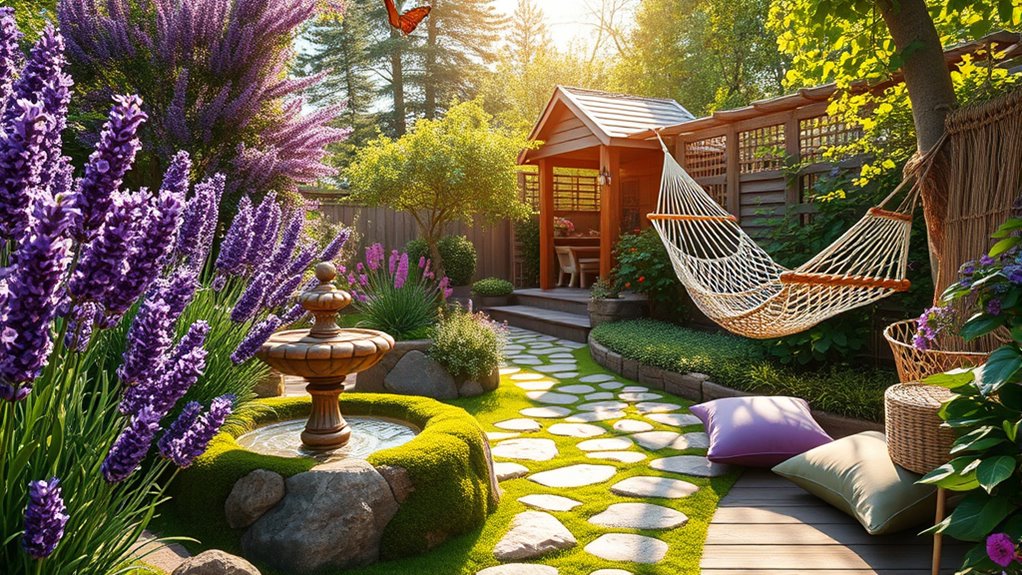To create a sensory garden, plan zones for sound, smell, touch, and taste, using pathways to guide visitors through different experiences. Select plants with vibrant colors, diverse textures, and pleasant scents, placing fragrant and tactile plants near seating areas. Add water features, wind chimes, and bird-friendly elements to boost auditory stimulation. Incorporate edible plants for taste, and include textured stones or sculptures for surprises. Continue exploring to discover how to craft an inviting, multisensory outdoor oasis.
Key Takeaways
- Design distinct zones for sound, smell, touch, and movement, with pathways guiding visitors through various sensory experiences.
- Select a diverse range of plants with different textures, fragrances, and visual features to stimulate multiple senses.
- Incorporate tactile elements like water features, textured sculptures, and natural materials to enhance tactile engagement.
- Add auditory features such as water fountains, wind chimes, and bird attractants to create a soothing soundscape.
- Include edible plants and interactive components to foster multisensory exploration and deepen garden engagement.
Planning Your Sensory Garden Layout
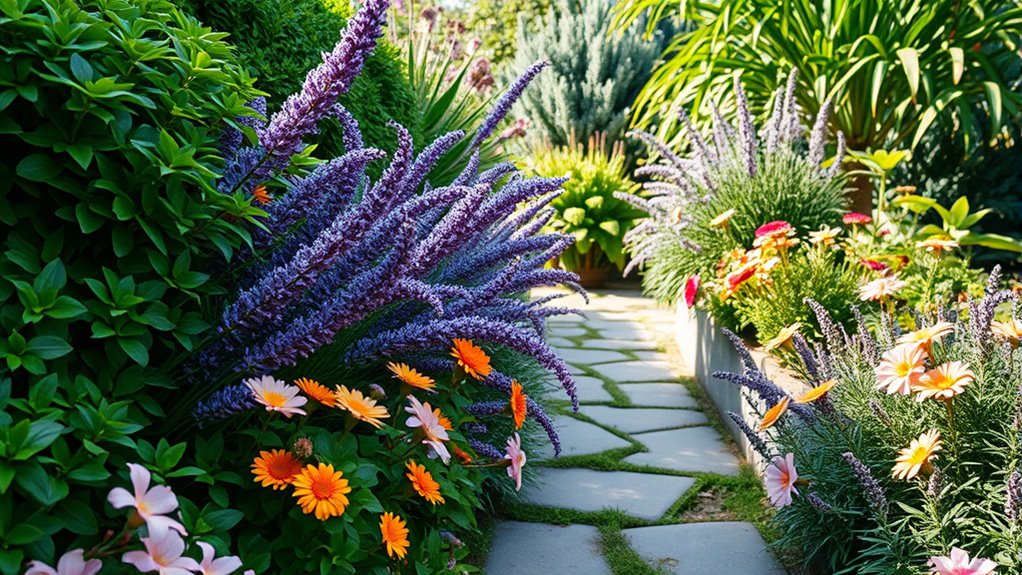
Before you begin planting, it’s important to carefully plan your sensory garden layout. Think about how you’ll arrange different zones for sound, smell, touch, and movement. Consider creating pathways that guide visitors through various sensory experiences, ensuring easy access and flow. Decide on designated areas for fragrant plants, textured foliage, and calming water features. Keep height variations in mind to add visual interest and accessibility. Incorporate visual contrast in your design to highlight certain features and create visual depth. Allocate space for seating so visitors can pause and enjoy their surroundings. Take note of sunlight patterns, ensuring plants and features thrive in your garden’s conditions. Sketch a layout to visualize different zones and their relationships, making adjustments before planting. Additionally, considering space utilization ensures that every area serves a purpose and enhances the overall sensory experience. Incorporating plant diversity can help attract a variety of sensory stimuli and wildlife, enriching the garden environment. Thoughtful garden design can further enhance the sensory engagement and create a harmonious outdoor space. A clear plan helps you maximize sensory engagement while maintaining an organized, inviting space.
Selecting Plants for Visual and Tactile Appeal
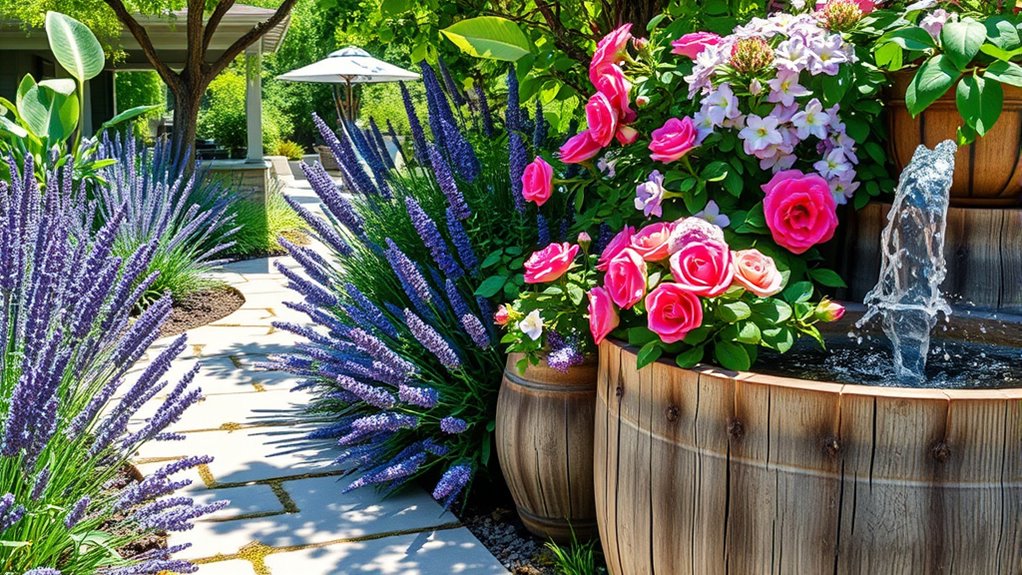
Choosing the right plants is essential for creating a sensory garden that stimulates both the eyes and the sense of touch. Focus on varieties with diverse textures, such as soft, velvety leaves or rough, ridged surfaces. Incorporate plants like lamb’s ear for a plush feel, succulents for their firm surfaces, and ferns for delicate fronds. Use vibrant colors and interesting shapes to captivate your visual senses. Mix tall, spiky plants with rounded, low-growing ones to add visual interest. Confirm the plants are suitable for your climate and soil conditions. Additionally, selecting plants with appropriate tire pressure can help ensure they thrive in your garden environment. Proper watering techniques are also crucial for maintaining healthy plants and encouraging diverse textures and colors. By thoughtfully selecting a variety of textures and colors, you’ll create a space that invites exploration through sight and touch, making your garden an engaging, multisensory experience. Incorporating automation technologies into your gardening practices can streamline maintenance and ensure optimal plant health, enhancing the overall sensory experience. Regular monitoring of plant health can prevent issues before they become severe, ensuring your sensory garden remains vibrant and inviting.
Incorporating Fragrant Flora to Engage Smell

Adding fragrant plants to your sensory garden enhances the experience by engaging the sense of smell alongside sight and touch. Choose plants that emit pleasant, noticeable scents, such as lavender, jasmine, or rosemary. Place them near seating areas or pathways so you can enjoy their aroma as you walk or relax. Layer different fragrances to create an evolving sensory experience throughout the day. Consider planting some flowers like gardenias or peonies that release a strong scent during bloom. Be mindful of fragrance intensity to avoid overwhelming your senses. Regularly prune and care for your plants to keep their scent vibrant. Incorporating fragrant flora not only delights your senses but also attracts pollinators, enriching your garden’s overall ambiance. Understanding the different sensory engagement techniques can help you design a more immersive and balanced garden experience. To optimize your sensory garden, incorporate plant selection strategies that enhance fragrance diversity and seasonal interest.
Adding Textural Elements and Surprising Touchpoints
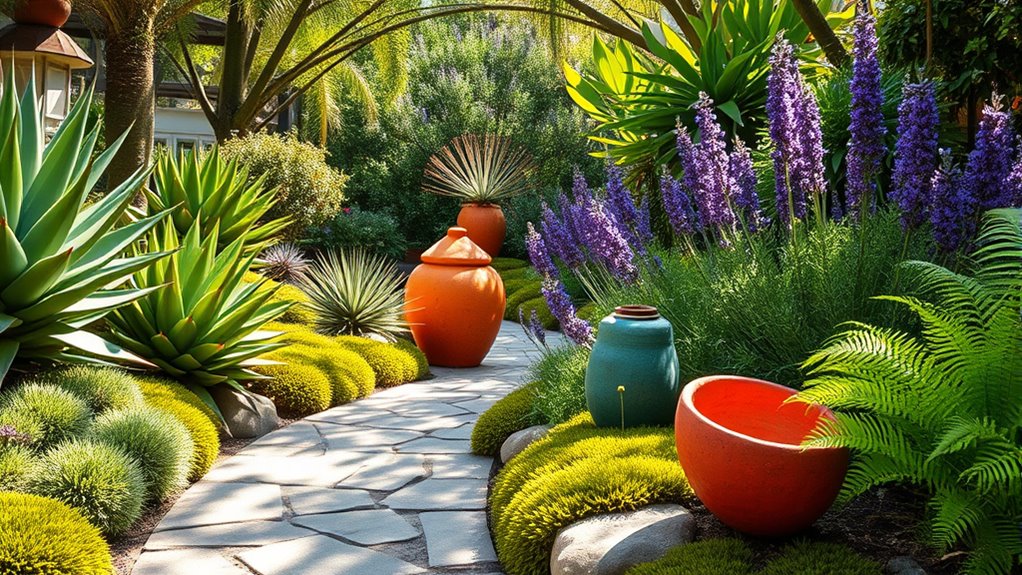
Incorporating a variety of textures and unexpected touchpoints can transform your sensory garden into a mesmerizing oasis. Choose plants with different leaf textures—smooth, rough, fuzzy, or leathery—to invite visitors to explore through touch. Add elements like bark, rocks, or bark chips to create diverse tactile experiences. Introduce unexpected features such as a bubbling water fountain, a pebble mosaic, or textured sculptures to surprise visitors and encourage curiosity. Incorporate soft fabrics like outdoor cushions or woven mats for inviting resting spots. You can also include natural materials like driftwood or shells, which add unique tactile elements. These diverse textures and surprises make your garden more engaging, encouraging visitors to connect through their sense of touch while enriching the overall sensory experience.
Designing Auditory Features for a Melodic Atmosphere
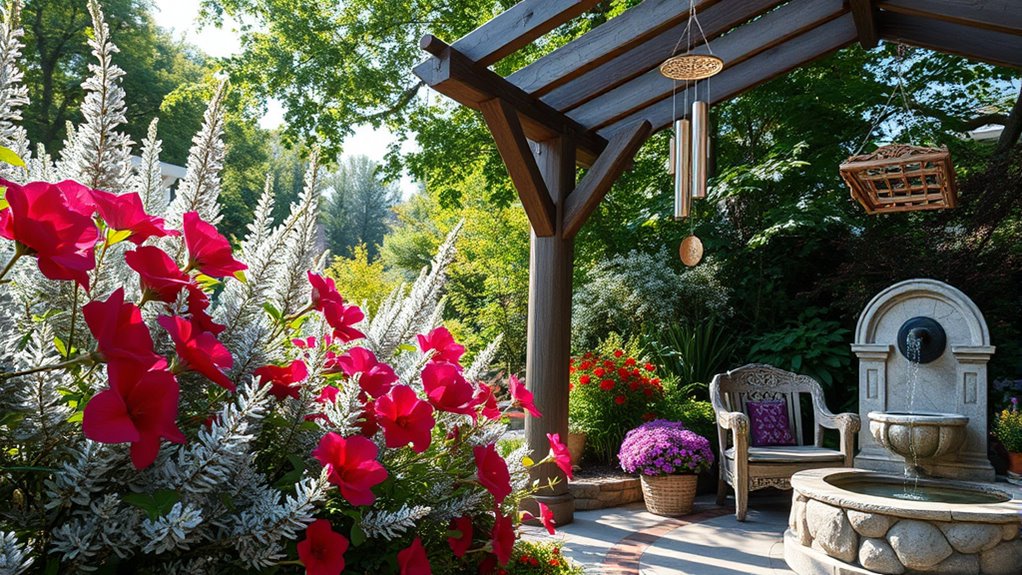
Creating auditory features in your sensory garden transforms it into a living symphony, engaging visitors through sound as vividly as through touch and sight. You can incorporate various elements to produce soothing melodies or lively sounds that enhance the environment. Think about strategically placing water features like fountains or small cascades, which create calming noise. Wind chimes and bells add gentle, melodic tones, while rustling grasses and leaves respond naturally to the breeze. Birdhouses and feeders attract local birds, filling the space with cheerful chirping. You can also include sound sculptures or musical instruments designed for outdoor use to encourage interactive play and spontaneous melodies. These features make the garden lively, immersive, and uniquely engaging for all visitors. By integrating industry trends, you can optimize the placement and variety of auditory elements to create a harmonious sensory experience. Additionally, applying predictive modeling in educational data mining can help anticipate which auditory features resonate most with different visitors, further enhancing the sensory richness of your garden. Incorporating soundscape design principles can also guide you in creating a balanced and pleasing auditory environment that adapts to different times of day and weather conditions. Paying attention to natural sound sources ensures that the garden’s soundscape remains authentic and soothing, complementing the other sensory elements.
Introducing Edible Elements to Stimulate Taste
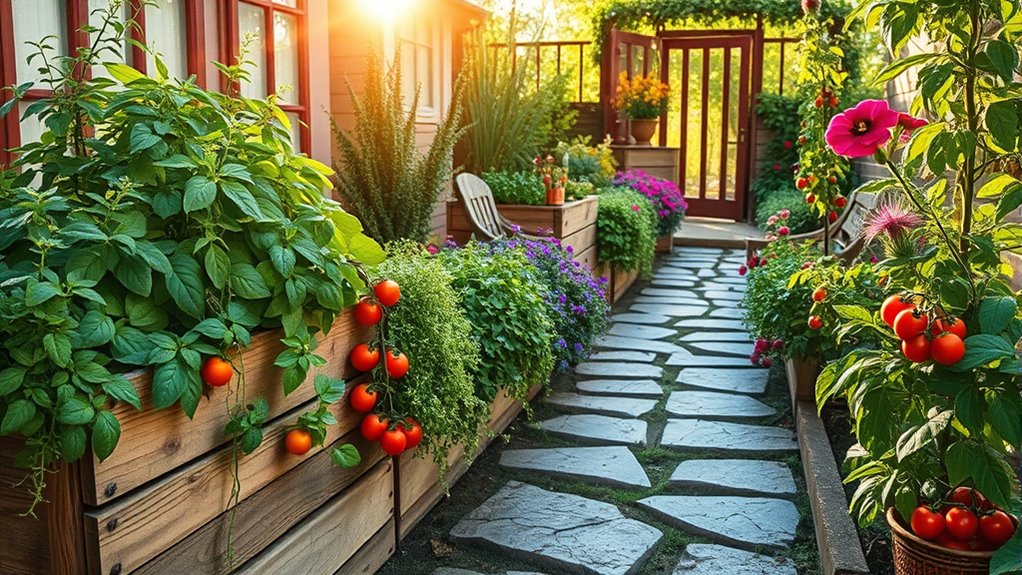
Introducing edible elements into your sensory garden offers a delightful way to engage visitors’ senses of taste while enhancing the overall experience. Incorporate herbs like basil, mint, or thyme, which add fresh flavors and aromatic appeal. Small fruit plants such as strawberries or blueberries can provide sweet surprises and encourage interaction. Vegetables like cherry tomatoes or peppers not only taste great but also add visual interest. When selecting edible plants, consider their growth requirements and maintenance needs to ensure success. Place them near pathways or seating areas so visitors can easily enjoy a nibble or smell. Incorporating edible plant varieties can also add a refreshing element to your outdoor space, making it more inviting. Proper portioning raw food into manageable servings ensures freshness and encourages interaction with the edible elements. Including edible elements creates a multisensory experience, fostering curiosity and making your garden a memorable, engaging space for everyone.
Frequently Asked Questions
How Can I Ensure My Sensory Garden Is Accessible for All Visitors?
To guarantee your sensory garden is accessible for all visitors, you should include wide, smooth pathways for easy navigation, especially for those with mobility challenges. Use tactile elements like textured plants and surfaces, clear signage with large fonts, and provide seating areas throughout. Incorporate audio features like wind chimes or water sounds, and ensure height-appropriate plantings. Regularly seek feedback from diverse users to improve accessibility and make your garden welcoming for everyone.
What Safety Considerations Are Important When Designing a Sensory Garden?
Safety is your top priority when designing a sensory garden. You should avoid sharp edges, toxic plants, and uneven surfaces that could cause falls. Make sure pathways are wide, slip-resistant, and clearly marked. Install sturdy handrails where needed and guarantee good lighting for visibility. Regularly inspect plants for allergens or hazards, and keep the space clutter-free. Balancing beauty with safety guarantees an inviting, secure environment for everyone to enjoy.
How Do I Maintain a Sensory Garden Throughout Different Seasons?
To keep your sensory garden vibrant through the seasons, you should regularly check plant health, prune as needed, and replace seasonal plants to maintain variety. Mulch helps retain moisture and insulates roots during winter, while watering adjusts with weather changes. Keep paths clear and safe, and add seasonal touches like fragrant herbs in summer or colorful berries in fall. Staying attentive guarantees your garden remains engaging year-round.
Can I Incorporate Technology to Enhance Sensory Experiences?
You might think technology could ruin the natural feel of your sensory garden, but it actually enhances your experience. You can add weather-resistant speakers to play soothing sounds, install motion-activated lights to highlight different plants, or use tactile devices that produce gentle vibrations. These tools engage your senses more deeply and can be tailored to suit seasonal changes, making your garden a dynamic, immersive space that excites and relaxes you year-round.
What Budget Considerations Should I Keep in Mind When Creating a Sensory Garden?
When planning your sensory garden, you should consider your overall budget and prioritize cost-effective options. Focus on affordable plants, DIY installations, and natural materials to keep expenses low. Be mindful of ongoing maintenance costs for certain plants and features. Set aside funds for unexpected expenses, and look for discounts or secondhand items. Balancing quality and affordability guarantees you create an engaging, sustainable space without overspending.
Conclusion
As you nurture your sensory garden, remember it’s more than just plants—it’s a living symphony of your senses and soul. Each element, from fragrant blooms to textured leaves, symbolizes growth, discovery, and connection. By creating this vibrant oasis, you invite nature’s poetry into your life, awakening your spirit with every touch, scent, sound, and taste. Embrace this sanctuary as a reflection of your inner world, where every sense is a key to deeper harmony.
